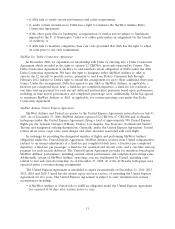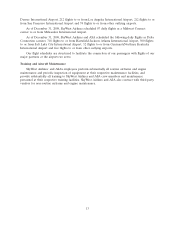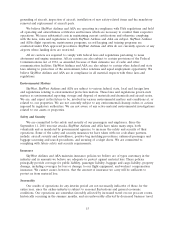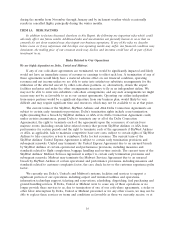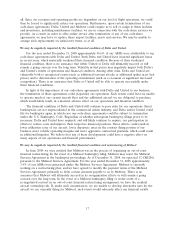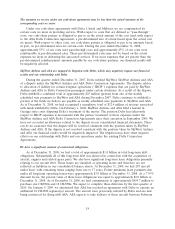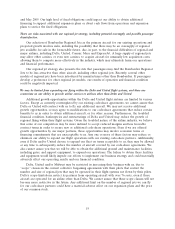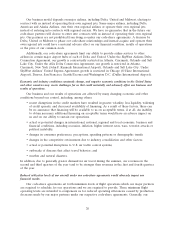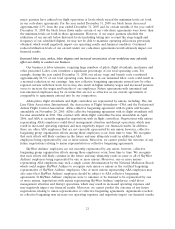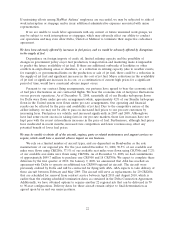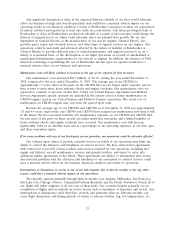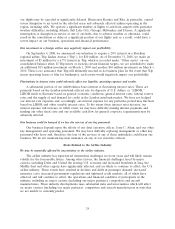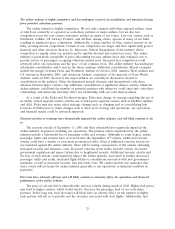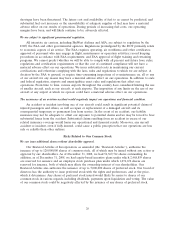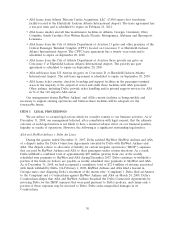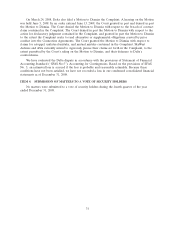SkyWest Airlines 2008 Annual Report Download - page 25
Download and view the complete annual report
Please find page 25 of the 2008 SkyWest Airlines annual report below. You can navigate through the pages in the report by either clicking on the pages listed below, or by using the keyword search tool below to find specific information within the annual report.major partners have utilized our flight operations at levels which exceed the minimum levels set forth
in our code-share agreements. For the year ended December 31, 2008 our block hours decreased
approximately 4.3% from the year ended December 31, 2007 and for certain months of the year ended
December 31, 2008 the block hours flown under certain of our code-share agreements were lower than
the minimum levels set forth in those agreements. However, if our major partners schedule the
utilization of our aircraft below historical levels (including taking into account the stage length and
frequency of our scheduled flights), we may not be able to maintain operating efficiencies previously
obtained, which would negatively impact our operating results and financial condition. Continued
reduced utilization levels of our aircraft under our code-share agreements would adversely impact our
financial results.
Increased labor costs, strikes, labor disputes and increased unionization of our workforces may adversely
affect our ability to conduct our business.
Our business is labor intensive, requiring large numbers of pilots, flight attendants, mechanics and
other personnel. Labor costs constitute a significant percentage of our total operating costs. For
example, during the year ended December 31, 2008, our salary, wage and benefit costs constituted
approximately 22.3% of our total operating costs. Increases in our unionized labor costs could result in
a material reduction in our earnings. Any new collective bargaining agreements entered into by other
regional carriers with their work forces may also result in higher industry wages and increased pressure
on us to increase the wages and benefits of our employees. Future agreements with unionized and
non-unionized employees may be on terms that are not as attractive as our current agreements or
comparable to agreements entered into by our competitors.
ASA’s pilots, flight attendants and flight controllers are represented by unions, including: The Air
Line Pilots Association, International, the Association of Flight Attendants—CNA and the Professional
Airline Flight Control Association. ASA’s collective bargaining agreement with its pilots will become
amendable on November 20, 2010. ASA’s collective bargaining agreement with its flight attendants will
become amendable in 2011. The contract with ASA’s flight controllers became amendable in April
2006, and ASA is currently engaged in negotiations with its flight controllers. Negotiations with unions
representing ASA’s employees could divert management attention and disrupt operations, which may
result in increased operating expenses and may negatively impact our financial results. In addition,
there are other ASA employees that are not currently represented by any union; however, collective
bargaining group organization efforts among those employees occur from time to time. We recognize
that such efforts will likely continue in the future and may ultimately result in additional ASA
employees being represented by one or more unions. Moreover, we cannot predict the outcome of any
future negotiations relating to union representation or collective bargaining agreements.
SkyWest Airlines’ employees are not currently represented by any union; however, collective
bargaining group organization efforts among those employees occur from time to time. We recognize
that such efforts will likely continue in the future and may ultimately result in some or all of SkyWest
Airlines’ employees being represented by one or more unions. Moreover, one or more unions
representing ASA employees may seek a single carrier determination by the National Mediation Board,
which could require SkyWest Airlines to recognize such union or unions as the certified bargaining
representative of SkyWest Airlines’ employees. One or more unions representing ASA employees may
also assert that SkyWest Airlines’ employees should be subject to ASA collective bargaining
agreements. If SkyWest Airlines’ employees were to unionize or be deemed to be represented by one
or more unions, negotiations with unions representing SkyWest Airlines’ employees could divert
management attention and disrupt operations, which may result in increased operating expenses and
may negatively impact our financial results. Moreover, we cannot predict the outcome of any future
negotiations relating to union representation or collective bargaining agreements. Agreements reached
in collective bargaining may increase our operating expenses and negatively impact our financial results.
21


